Author: Techub Selected Compilation
Written by: Louie
Compiled by: Yangz, Techub News
Those who know me know that I have always been a staunch supporter of Solana (sometimes even to the point of being a headache). This article aims to explain my core views on Solana and where I think the future of the ecosystem is headed.
In 2021, Solana survived on speed. In 2022, it sought self-salvation. And by 2024, it was already shaping a culture. However, as the industry cycle deepens, a sharp question always lingers around the Solana ecosystem: Is this chain just a Memecoin casino in a fancy coat?
The voices of critics are not without reason. From BONK to WIF, Memecoin has indeed dominated public perception and gained the fanatical pursuit of users, traders and KOLs. It is easy for people to confuse short-term noise with long-term value, but history tells us that ecological evolution has never been a straight line. Today's seemingly impetuous bubble may be laying the foundation for future asset distribution, innovative experiments and even practical applications.
So, where is Solana going in the next five years?
From throughput to application scenarios
Solana's architecture is centered on throughput, and its core proposition is to become a global state machine, provide low-cost block space, and process transactions in parallel. Solana not only wants to be fast enough to keep up with the pace of the Internet, but also wants to become the back-end infrastructure of the Internet.
Although such a design did give rise to the viral Memecoin and the prosperity of on-chain perpetual contracts, the real test is: Can the same infrastructure carry more lasting value?
At present, we have seen some good signs:
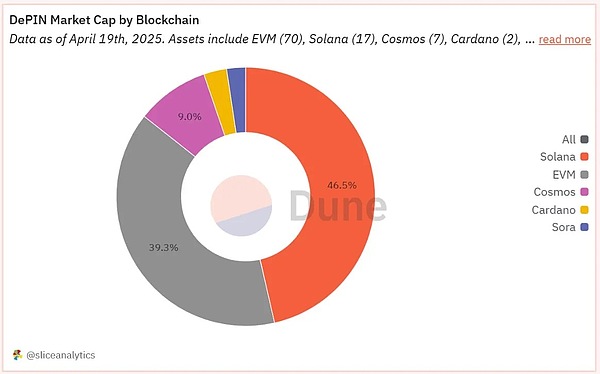
Solana is becoming the intersection of AI and cryptocurrency innovation. Intelligent agent-based systems (robot autonomy and smart contracts/marketplaces/user interactions) have found a natural fit on Solana. Even the Virtuals protocol, which was born on Base, has expanded to Solana because it sees the advantages of Solana's low latency, composability, and liquidity.
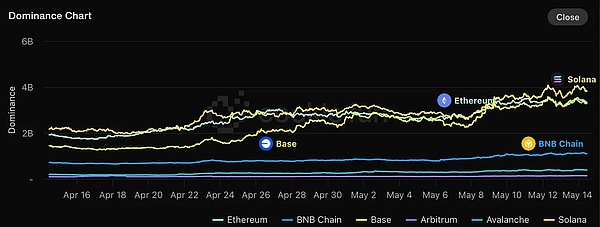
Solana's speed is not only good for building casinos, but also for coordination. It enables humanized rather than mechanical feedback loops, including instantly settled transactions, smooth experiences, and applications that blur the boundaries between Web2 user experience and Web3 sovereignty.
In this era of accelerated evolution, the success of blockchain is not only about decentralization, but also about whether it can keep pace with the times. Solana's high speed and low cost advantages are not only conducive to the creation of casinos, but also a frictionless infrastructure that supports complex collaboration, consumer-level experiences, and real-time markets.
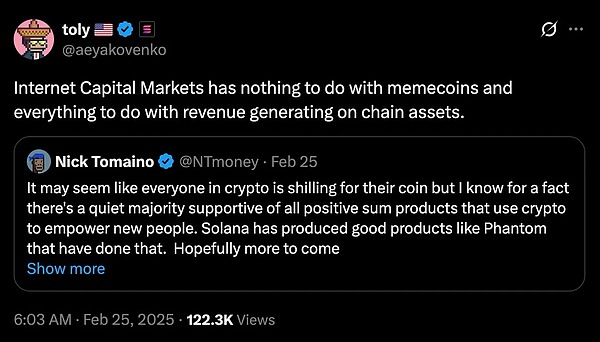
Market layout for hundreds of millions of users
Ethereum has achieved "product market matching" with capital, while Solana is aiming for cultural identity.
This difference is crucial. The capital-first ecosystem serves institutions and DAOs, entities with long-term vision, deep pockets, and a preference for composable financial instruments. In contrast, the culture-first ecosystem is built for ordinary people. It pursues frictionless user onboarding, expressive tools, and viral moments. The former expands through governance frameworks, while the latter grows at scale with memes, creators, and mobile native apps.
Solana's most commonly used applications (such as Phantom, Tensor, and Jupiter) are full of the temperament of Web2 consumer products, and this is no accident. This is not a simple brand packaging, but a deep strategic choice. When the next billion users will come from mobile phones, games, and social applications rather than trading terminals or DeFi panels, Solana's route is clear: actively adapt to user habits rather than letting users adapt to technology.
Over the next five years, this strategy will be condensed into a new user service stack:
Mobile-first experience will go from an add-on to a requirement
Social protocols such as Dialect will become the neural connections between on-chain identities
The chain abstraction layer will completely hide the technical backend, and users will not even know that they are using Solana
Solana’s real advantage lies not only in technical efficiency, but also in cultural penetration. It knows that in the long run, mass adoption will not be won by white papers and token economics, but by intuitive and even fun touchpoints. In other words: it is not important to make Solana visible everywhere, but to make Solana accessible.
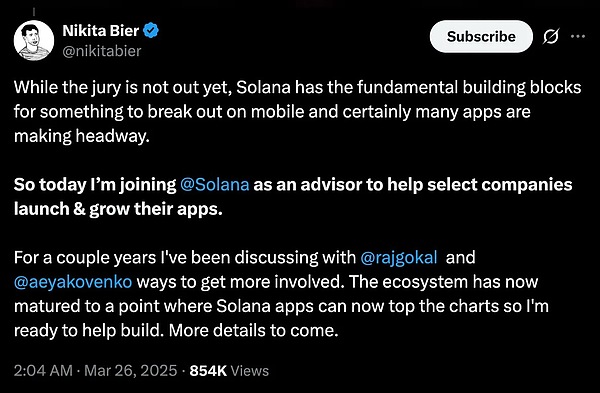
Casinos are a feature, not a bug
Let’s face it: speculation has always been the most effective market entry strategy for cryptocurrencies.
Memecoins may be loud and flamboyant, but they are unrivaled attention engines—no user acquisition funnel or funding program can match the power of their narrative expansion. Whether you agree or not, Solana’s Memecoin wave is driving growth in transaction volume, wallet creation, developer interest, and cultural influence. All this without the support of airdrops, rebates, or token incentives. This is organic liquidity, not mercenary capital flow. It’s noisy, but it’s real.
Casinos bring liquidity, and liquidity breeds vitality. The real difference is not whether you can attract gamblers, but whether you can keep them. Speculation is just a stepping stone, and the world behind the door is where the real opportunity lies.
Speculation is inevitable, but how the ecosystem handles it determines whether it will become a Ponzi playground or an economic sandbox. Solana did not try to deny the existence of speculation, but quietly laid the track to channel this energy in a more lasting direction. Ultimately, the key is not to resist the casino, but to transcend its limitations.

Solana's Strategic Moat
Solana's real advantage lies not only in technology, but also in "coordination ability." At a time when the blockchain industry is obsessed with modularity and extremist ideology, Solana's monolithic architecture is often belittled as a design compromise. But perhaps its real advantage has nothing to do with architecture, but "operational efficiency"?
The Solana Foundation has clear goals, sets long-term priorities, and funds research and development. It does not chase hot spots, but defines the rhythm. Whether it is allocating funds for mobile-first experiences, optimizing validator incentives, or subsidizing key infrastructure such as RPC service providers and client diversity, the foundation operates more like a risk studio than a think tank.
This clear sense of mission and calm advancement rhythm allow the entire ecosystem to develop strategically rather than fall into passive chaos. In an industry where most L1 teams are either absent or over-intervention, the Solana Foundation has found a rare balance: support but not suffocation.
Solana's ecological narrative is not perfect but effective. It doesn't have the exquisite brand control of Ethereum, nor the ideological purity of Bitcoin, but it has "potential energy". What it is building shows a kind of spontaneous coordination: fast application, low user experience cost and global user penetration. Whether it is DeFi, DePIN, games or AI, the common point is "large-scale availability". You can disagree with the noise, but the signal that cannot be ignored is that Solana is built for end users, not for niche governance token holders.
In addition, developers are producing efficiently. The early development experience of Solana was known for its harshness, such as only supporting Rust, lack of tools, and difficulty in getting started. However, these disadvantages are changing rapidly. Now they have better documentation, TypeScript SDK and growth funds than ever before.
This is a credible flywheel effect: better tools → more developers → better applications → more users → more funds → repeat. This advantage cannot be replicated by forks. The ability to coordinate has a compounding effect, and five years from now, Solana may be the chain of choice for real-time, consumer applications—not because it wins every narrative war, but because it wins every product demonstration.

The data doesn’t lie
Critics may scoff at Solana’s Memecoin frenzy, but the data tells a different story. Let’s parse a few key metrics through Blockworks’ Solana dashboard.
Q4 2024 and Q1 2025 were Solana’s strongest periods ever. Total on-chain application revenue, or chain GDP, grew 321% quarter-over-quarter to $825 million by the end of 2024. Moreover, the momentum continued into the new year, with Q1 2025 revenue reaching $819 million. January alone contributed $551 million, largely thanks to the controversial TRUMP issuance. In horizontal comparison, Solana's single-quarter revenue has surpassed its previous full-year performance.
This indicates that the protocol layer has achieved "product-market fit". Solana not only facilitates transactions, but also captures value from them, which is a sign of its economic maturity. When the protocol-level GDP grows so rapidly, it will trigger second-order effects, such as investor confidence, developer migration, and long-term sustainability.
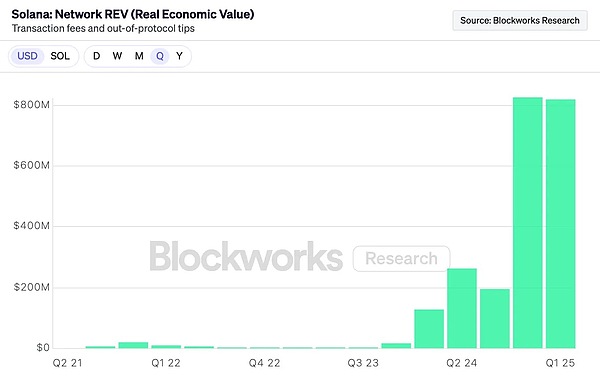
Just a year ago, the DeFi track of the Solana ecosystem was still regarded as a ghost town. Now it has become a capital hub. As of this writing, the Solana ecosystem DeFi total locked value (TVL) is $9.6 billion, just 19% below the peak in January 2025. After the LIBRA incident, many people had sentenced the chain to death. But liquidity is firmly returning and fundamentals are continuing to strengthen.
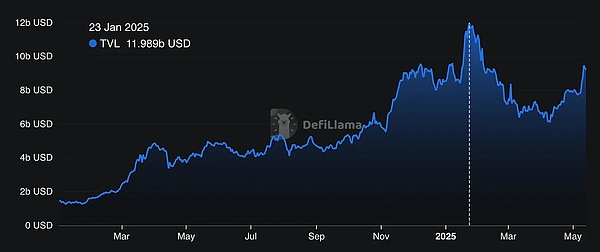
It is worth noting that these funds are not passive liquidity sitting in the fund pool, but active capital, shuttling between perpetual contract markets, decentralized exchanges and dynamic vaults. This growth marks two major turning points:
Rebuilding institutional confidence: TVL of this scale means that whales, consortiums, and funds are deploying heavily
Infrastructure resilience: Without a battle-tested architecture, it is impossible to carry this amount of capital. Solana's validator network, client improvements, and composability have finally merged into a stable ecosystem that can support the development of serious DeFi
All this is not based on luck, but on reconstruction and repetition.
Turn against the wind: Solana is poised to take off
Although Solana has experienced headwinds, multiple emerging potentials are pushing the ecosystem into an accelerated track.
Institutional demand awakens: With its speed advantage and solid fundamentals, Solana has quietly become an institutional darling. It is widely regarded as the strongest candidate for the next batch of cryptocurrency spot ETFs in the United States. Applications from institutions such as VanEck, Bitwise, Canary and Grayscale are under review and may be approved as early as October 2025. Canada is one step ahead, launching multiple Solana spot ETFs on the Toronto Stock Exchange in April 2025, with net inflows exceeding $86 million in the first week.
In addition, institutional enthusiasm is spreading to other areas. Inspired by the (Micro)Strategy Bitcoin Treasury strategy, SOL Strategies announced the establishment of a $500 million convertible note financing mechanism to create an investment tool focused on Solana. While not as large as Saylor’s “war chest,” this start signals that demand for the asset is growing.
The dawn of regulation: The crypto industry is experiencing its most favorable policy environment ever. The gradual clarity of the U.S. regulatory framework paves the way for major catalysts such as the Digital Asset Strategic Reserve (including Solana), further consolidating the legitimacy of the asset class. This shift will accelerate development cycles and boost investor confidence.
Performance breakthroughs are imminent: The Firedancer mainnet is expected to go live later this year, which may be a milestone in Solana’s evolution. Built from the ground up by Jump Crypto, this system promises to push Solana, already a speed champion, to new heights—exponentially increasing throughput, enhancing network reliability, and unlocking new scenarios such as high-frequency trading. More importantly, it introduces a second independent validator client, a key step towards true decentralization. If delivered on schedule, Firedancer will not only make Solana faster, but also stronger.

Summary: Beyond casinos, the future has arrived
Solana will always have casinos, but casinos never stifle innovation, they provide blood transfusions for innovation. These noisy places carry the functions of user education and stress testing infrastructure, and breed the liquid soil that nourishes all things. Memecoin, fanatics, and yield hunters are all part of Solana's evolution, not episodes that deviate from the main line.
In the next five years, what Solana has to do is not to get rid of this face, but to surpass this face. If a system that rewards short-term speculation and encourages long-term construction can be established on top of the carnival, it will have the opportunity to become a public chain that not only expands transaction volume but also expands trust.
Under all the noise, construction has never stopped. Firedancer is coming, real-world applications are awakening, and capital has completed the closed loop of reflux. As long as the cultural gene is not destroyed, Solana will eventually be the fastest blockchain in the crypto world and the one that laughs last. As Pantera Capital general partner Cosmo Jiang and investment analyst Eric Wallach said at the beginning of the year, "Even if innovation does not originate from Solana, it will eventually reach Solana."
 Anais
Anais












